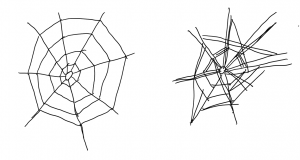
Do you remember the first time you saw a spider’s web? If you are like me, you were a young kid looking at it in a state of wonder. How can a spider create such a thing? Each thread looks perfectly placed and is clearly there for a reason. The threads come together to paint a picture of one of the most awe-inspiring parts of nature. I like to think of our brains in a similar way. Millions upon millions of connections come together, painting an intricate web between our ears, that ultimately makes up who we are.
The Web of ASD
Now I want you to think about taking that web and adding more and more threads. Now the perfect spider web is becoming muddled, with threads on top of each other where there shouldn’t be. Where there should be threads, there are too many, and now this perfect picture is becoming more and more confusing the more you look at it. This web does not look as functional, and it leads one to wonder what went wrong.
We can think of the brain, in almost an identical way to the muddled web as it relates to ASD. The causes of ASD are complex, to say the least, and involve a myriad of genetic and environmental risk factors. The effects, particularly on neural circuitry, are much better understood. Revisiting the spider web analogy, there are simply too many neuronal connections in ASD, as there would be in a crowded web. In a normal brain, around early childhood, neurons are pruned and refined to make connections more efficient. So in a more complex web, if a spider wants to travel from one side of the web to another, they are met with many more crossroads than would normally be anticipated. The spider ultimately takes longer to cross the web. Similarly in the brain, if a message needs to be sent across a greater distance the extra neuronal connections will mean that message is delivered slower and less efficient.

artract created by B. Swanson
Further complicating the brain in ASD, neurons can also simply be in the wrong place. Indeed, neural migration is also affected during ASD and during development. Now you can imagine a web with threads where they should not be, it does not look right, and maybe not even function right. With neurons in the wrong place, the issues of neural communication are further complicated.
Bringing it all Together
With the brain seeming so out of whack, it’s hard to imagine a scenario where this brain even work. In ASD, the brain is largely functional, however it would not be considered neurotypical. The inefficient wiring leads to some of the big picture symptoms such as:
- Difficulty with verbal and non-verbal language
- Gestures
- Facial expressions
- Expressions of emotion
- Lack of understanding of person space
The big picture symptoms are a result of a tangled web of neurons. However, the neurons mostly get the job done, and the messages sent, despite the difficulties. Much like a tangled spider’s web, it may not look and act how it should, but in the imperfection, there is a level of beauty.